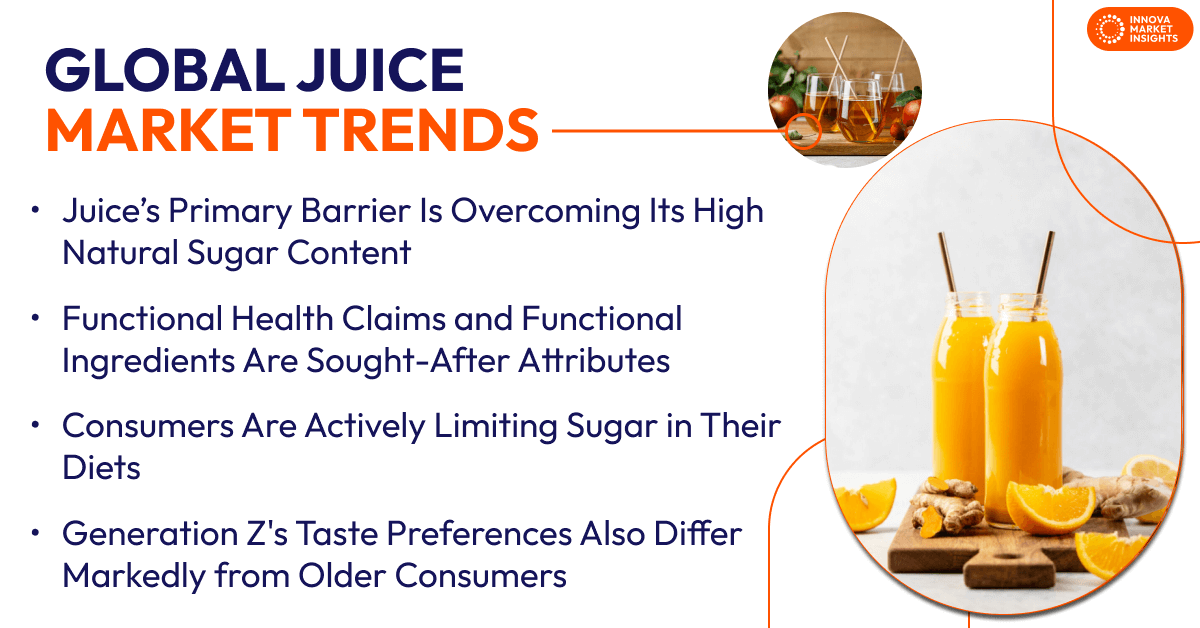June 25, 2025 – The juice industry stands at an important juncture as consistent growth and accelerating momentum pave the way ahead. The sector is primed for transformation, but this isn’t just expansion—it’s evolution driven by purpose.
Challenges are on the horizon, and the need for sugar reduction is top of the list. Requiring a response to recommendations from public health and nutrition professionals, regulations from governmental agencies, and demands from health-conscious consumers globally. Plus, competition from beverage categories and climate-driven crop failures are affecting supply costs.
Innova Market Insights’ report reveals how these challenges are perceived and the opportunities they present. Take a step inside the world of juice and juice drinks where blending staple fruits with lower-sugar, bold flavors, and better-for-you multi-juice formulations are appealing to consumers.
Dispelling Sugar Concerns Remains a Top Priority for Growth
Due to a decline in innovation in recent times, a challenge has appeared in the form of demand for products with reduced sugar, which is often championed by soft drinks. Juice’s primary barrier is overcoming its high natural sugar content, forcing most new sugar-reduced products to claim the less stringent no-added sugar instead of the sugar-free claim used by many new soft drinks.
In addition, companies are crossing categories to innovate with juice in carbonated and other growing adjacent categories. However, expectations of strengthening growth suggest confidence that juice companies will identify opportunities to help them meet these better-for-you demands with new juice products.
How Consumer Demand Has Shifted From Sugars to Flavors
The top fruit flavors in new juice launches have remained familiar and have largely retained the same rank positions. However, if they wish to attract more consumers, brands must look past these traditional flavors to excite consumers, particularly younger generations, with new flavor and ingredient combinations.
Some new flavors in the juice market suggest where innovation might go. Fruit and vegetable combinations, as well as blending greens, can help lower sugar levels while maintaining various health benefits. By creating novel flavor and ingredient combinations, companies can shift the conversation from sugar to flavor, reach new audiences, and expand usage to occasions beyond breakfast.

Gen Z Preferences Will Guide Future Trends
Generation Z has an affinity for global cuisines, a taste for adventurous flavors, and a bias toward products that support their healthy outdoor lifestyle with functional ingredients and ethically conscious packaging. Functional health claims and functional ingredients are sought-after attributes. Yet, juices have not gained ground beyond immunity, added vitamins and minerals.
Juices’ agricultural roots influence producers’ investment in protecting the environment. Juice is well ahead of other soft drinks in making this claim, aligning with Generation Z’s values.
Therefore, 360-degree social engagement with Generation Z is essential to gaining their attention. While experiential events, subscriptions, influencer endorsements, and personalization will build community and expand consumption.
Juice Under Pressure Amid Soft Drink Innovation
Consumer preferences have shifted away from sugary soft drinks, with nearly half of consumers globally actively limiting sugar in their diets. Research, media, and governmental regulations back these health-based concerns.
The soft drink industry has responded by focusing on functional beverages that deliver genuine health benefits. This strategic realignment has generated impressive results: soft drink launches have surged consistently in recent years, demonstrating the sector’s ability to evolve and capture emerging demand.
If juice producers remain focused on non-juice subcategories, it will put the juice market at risk, which will mean juice innovation will continue to decline. If some companies continue with their stated intent to prioritize innovation when divesting their juice portfolio, launch growth could turn positive. However, brands are also unduly impacted by extreme weather events due to climate change – another barrier to resuming growth.
How Will Companies Innovate With Health Benefits and Gen Z Preferences?
Consumers worldwide show a strong preference for juices with added health benefits like fiber or vitamins. This trend is particularly pronounced among Generation Z, where many are in favor of enhanced juices versus those who prefer basic options. While Boomers also lean toward health-enhanced products, the preference is less decisive.
Generation Z’s taste preferences also differ markedly from older consumers. Younger drinkers gravitate toward bold, intense flavors and multi-fruit blends, while Boomers show no clear preference between intense and mild tastes and actually favor single-juice varieties over multi-fruit flavors.
What’s Next for Juice & Juice Drinks?
The juice market is evolving through several key innovations. Sugar reduction remains a priority, with manufacturers incorporating vegetables and coconut water as natural alternatives, while fiber enrichment offers dual benefits of improved nutrition and slower sugar absorption.
Flavor development is intensifying, with brands exploring bolder taste profiles and complex fruit combinations. Meanwhile, smaller craft producers are gaining market share by positioning their products on broader good-for-you, good-for-the-planet platforms
As companies achieve carbon neutrality and other sustainability milestones, ethical messaging will become prominent in marketing strategies. Additionally, the juice market is diversifying with purpose-driven products designed for specific consumption occasions and daily routines.
This article is based on Innova’s Juice & Juice Drinks – Global report. This report is available to purchase or with an Innova Reports subscription. Reach out to find out more
